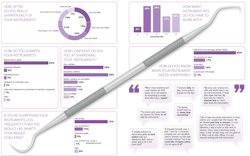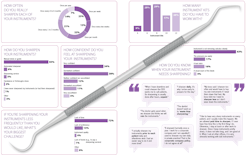Sharpening in the trenches
Results from the RDH magazine State of Sharpening Survey
You’ve probably heard the recommendation that you sharpen your instruments each day—and maybe you laughed. As the dental hygienist’s role as prevention specialist continues to expand, hygienists have found themselves with new responsibilities ranging from blood pressure readings to oral cancer screenings. And less positively, some practices are scheduling shorter and shorter hygiene appointments in order to squeeze more money out of hygienists. Either way, many hygienists feel pressed for time and find making time for sharpening difficult.
Regardless of the reason, hygienists are busy, and most will readily tell you that their instruments are not as sharp as they could—or should—be. And while the prophylactic appointment is slowly but surely being recognized as more than “just a cleaning,” the manual removal of calculus is still at the heart of an appointment.
Knowing that this is a common pain point (sometimes literally—dull instruments are associated with occupational pain), RDH magazine reached out to readers in the form of a survey to ask about what sharpening looks like to you—how often are you doing it? How do you do it? What’s getting in your way?
In this five-part series, we’ll be digging into the results as well as important information related to sharpening—ergonomics, time management and productivity, clinical impacts, and the hands-on aspect of sharpening. Catch the features here in the coming months!

